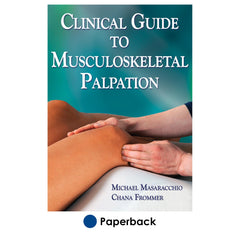The importance of palpation as a component of examination
This is an excerpt from Clinical Guide to Musculoskeletal Palpation by Michael Masaracchio & Chana Frommer.
Palpation is a psychomotor skill and should be viewed as a component of the examination process. The examination usually includes, at the very least, a thorough history, range of motion assessment, muscle strength testing, special tests, joint mobility assessment, neurological assessment, and outcome scales. The information gleaned from the palpatory examination needs to be integrated into the remainder of the examination. This compilation of all the gathered data guides the clinician in establishing the diagnosis and implementing treatment strategies; it also assists in the clinical decision-making process.
Often, students and novice clinicians struggle with the timing of palpation during the examination. While currently there is no set framework for when to conduct the palpatory part of the examination, we recommend using clinical reasoning skills to help answer this question. During the examination, it is important to pay close attention to the behavior of the symptoms reported by the patient. For example, you should question patients about symptom behavior so that you can ascertain if the condition has been getting worse, staying the same, or improving since the initial onset of pain or injury. When a patient reports high pain levels and is extremely apprehensive of movement, this usually indicates an acute injury. Conversely, when a patient reports lower levels of pain and is less apprehensive about movement, this is usually indicative of a condition in the subacute or chronic phase of healing (Maitland, 2006). According to Maitland (2006), one of the main objectives of the examination process is to assess the degree of irritability. A highly irritable structure is characterized by high levels of pain with movement, an increase in pain following minimal activity, and a longer period of time for pain to return to baseline levels (Maitland, 2006). This information can be used to help determine the sequence of the examination process.
After trauma to the musculoskeletal system, an inflammatory response occurs. This is characterized by redness, heat, swelling, and pain. The goal of the inflammatory phase is to remove dead cells from the site of injury and prevent infection from occurring. This phase lasts approximately 7 days and sets the stage for the remainder of the healing process. The second phase of tissue healing is the repair phase, characterized by migration of fibroblasts to the site of the wound to continue tissue healing (Gogia, 1992; Moore, Nichols, & Engles, 2010). The most important part of this phase is collagen formation to give the wound tensile strength. This phase lasts anywhere from 3 to 20 days. The final phase of healing, the remodeling phase, is characterized by scar formation and conversion of type III collagen to type I collagen, the main type found in connective tissue. This phase begins around day 10 and continues until the tissue has returned to pre-injury strength. It is important to remember that these phases are not mutually exclusive of one another and that significant overlap occurs throughout the process (Gogia, 1992; Moore et al., 2010).
Palpation can sometimes irritate tissues, which may affect the accuracy of the information gathered from the remaining portions of the examination (range of motion, muscle testing, and so on). The information from the patient history should tell the clinician the degree of irritability present. This guides the clinician as to whether palpation should be performed at the beginning or the end of the examination. Because this determination requires continuous clinical decision making, it can be difficult for students and novice clinicians. Therefore, in our opinion, a general rule of thumb can be helpful - that palpation belongs at the end of the examination. This provides clinicians with a standardized point in the examination to conduct palpation and lessens the chance that palpation will irritate tissues.
Read more from Clinical Guide to Musculoskeletal Palpation by Michael Masaracchio and Chana Frommer.
More Excerpts From Clinical Guide to Musculoskeletal Palpation

Get the latest insights with regular newsletters, plus periodic product information and special insider offers.
JOIN NOW


